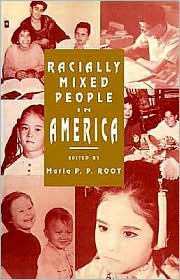The Sum of Our Parts: Mixed-Heritage Asian AmericansPosted in Anthologies, Asian Diaspora, Books, Census/Demographics, Media Archive, Politics/Public Policy, United States on 2009-10-15 20:55Z by Steven |
The Sum of Our Parts: Mixed-Heritage Asian Americans
Temple University Press
June 2001
296 pages
7×10
2 tables 4 figures 3 halftones
paper: EAN: 978-1-56639-847-3 (ISBN: 1-56639-847-9)
edited by Teresa Williams-León and Cynthia L. Nakashima, foreword by Michael Omi
Largely as a result of multiracial activism, the US Census for 2000 offers people the unprecedented opportunity to officially identify themselves with more than one racial group. Among Asian-heritage people in this country and elsewhere, racial and ethnic mixing has a long but unacknowledged history. According to the last US Census, nearly one-third of all interracial marriages included an Asian-descent spouse, and intermarriage rates are accelerating. This unique collection of essays focuses on the construction of identity among people of Asian descent who claim multiple heritages.
In the U.S., discussions of race generally center on matters of black and white; mixed heritage Asian Americans usually figure in conversations about race as an undifferentiated ethnic group or as exotic Eurasians. The contributors to this book disrupt the standard discussions by considering people of mixed Asian ethnicities. They also pay particular attention to non-white multiracial identities to decenter whiteness and reflect the experience of individuals or communities who are considered a minority within a minority. With an entire section devoted to the Asian diaspora, The Sum of Our Parts suggests that questions of multiracial and multiethnic identity are surfacing around the globe. This timely and provocative collection articulates them for social scientists and students.
Table of Contents
- Foreword – Michael Omi
- Acknowledgments
- Introduction: Reconfiguring Race, Rearticulating Ethnicity – Teresa Williams-León and Cynthia L. Nakashima
- Part I: Multiraciality and Asian America: Bridging the Hybrid Past to the Multiracial Present
- 1. Who Is an Asian? Who Is a Pacific Islander? Monoracialism, Multiracial People, and Asian American Communities – Paul Spickard
- 2. Possibilities of a Multiracial Asian America – Yen Le Espiritu
- 3. Servants of Culture: The Symbolic Role of Mixed-Race Asians in American Discourse – Cynthia L. Nakashima
- 4. “The Coming of the Neo-Hawaiian American Race”: Nationalism and Metaphors of the Melting Pot in Popular Accounts of Mixed-Race Individuals – John Chock Rosa
- Part II: Navigating Sociocultural Terrains of Family and Identity
- 5. Factors Influencing the Variation in Racial and Ethnic Identity of Mixed-Heritage Persons of Asian Ancestry – Maria P. P. Root
- 6. Alaska’s Multiracial Asian American Families: Not Just at the Margins – Curtiss Takada Rooks
- 7. The Diversity of Biracial Individuals: Asian-White and Asian-Minority Biracial Identity – Christine C. Iikima Hall and Trude I. Cooke Turner
- 8. Black, Japanese, and American: An Asian American Identity Yesterday and Today – Michael C. Thornton and Harold Gates
- Part III: Remapping Political Landscapes and Communities
- 9. A Rose by Any Other Name: Names, Multiracial/Multiethnic People, and the Politics of Identity – Daniel A. Nakashima
- 10. Multiracial Comedy as a Commodity in Hawaii – Darby Li Po Price
- 11. Doing the Mixed-Race Dance: Negotiating Social Spaces Within the Multiracial Vietnamese American Class Typology – Kieu Linh Caroline Valverde
- 12. The Convergence of Passing Zones: Multiracial Gays, Lesbians, and Bisexuals of Asian Descent – Teresa Williams-León
- 13. Mirror, Mirror, on the Wall: Mapping Discussions of Feminism, Race, and Beauty in Japanese American Beauty Pageants – Rebecca Chiyoko King
- 14. Mixed but Not Matched: Multiracial People and the Organization of Health Knowledge – Cathy J. Tashiro
- Part IV: Asian-Descent Multiraciality in Global Perspective
- 15. “We Paved the Way”: Exemplary Spaces and Mixed Race in Britain – David Parker
- 16. A Dutch Eurasian Revival? – Mark Taylor Brinsfield
- 17. Multiethnic Lives and Monoethnic Myths: American-Japanese Amerasians in Japan – Stephen Murphy-Shigematsu
- 18. The Racial Politics of Being Dogla and of “Asian” Descent in Suriname – Loraine Y. Van Tuyl
- 19. The Tiger and His Stripes: Thai and American Reactions to Tiger Woods’s (Multi-) “Racial Self” – Loraine Y. Van Tuyl
- Bibliography
- About the Contributors


